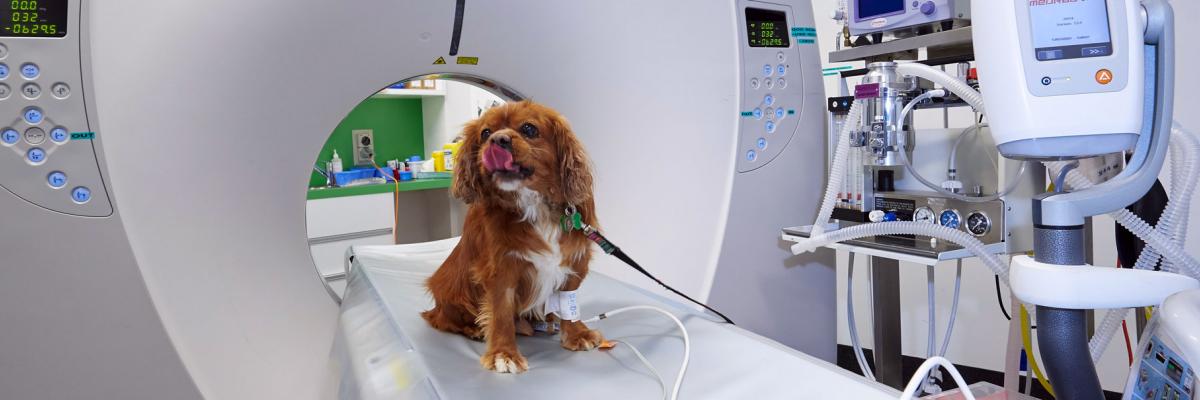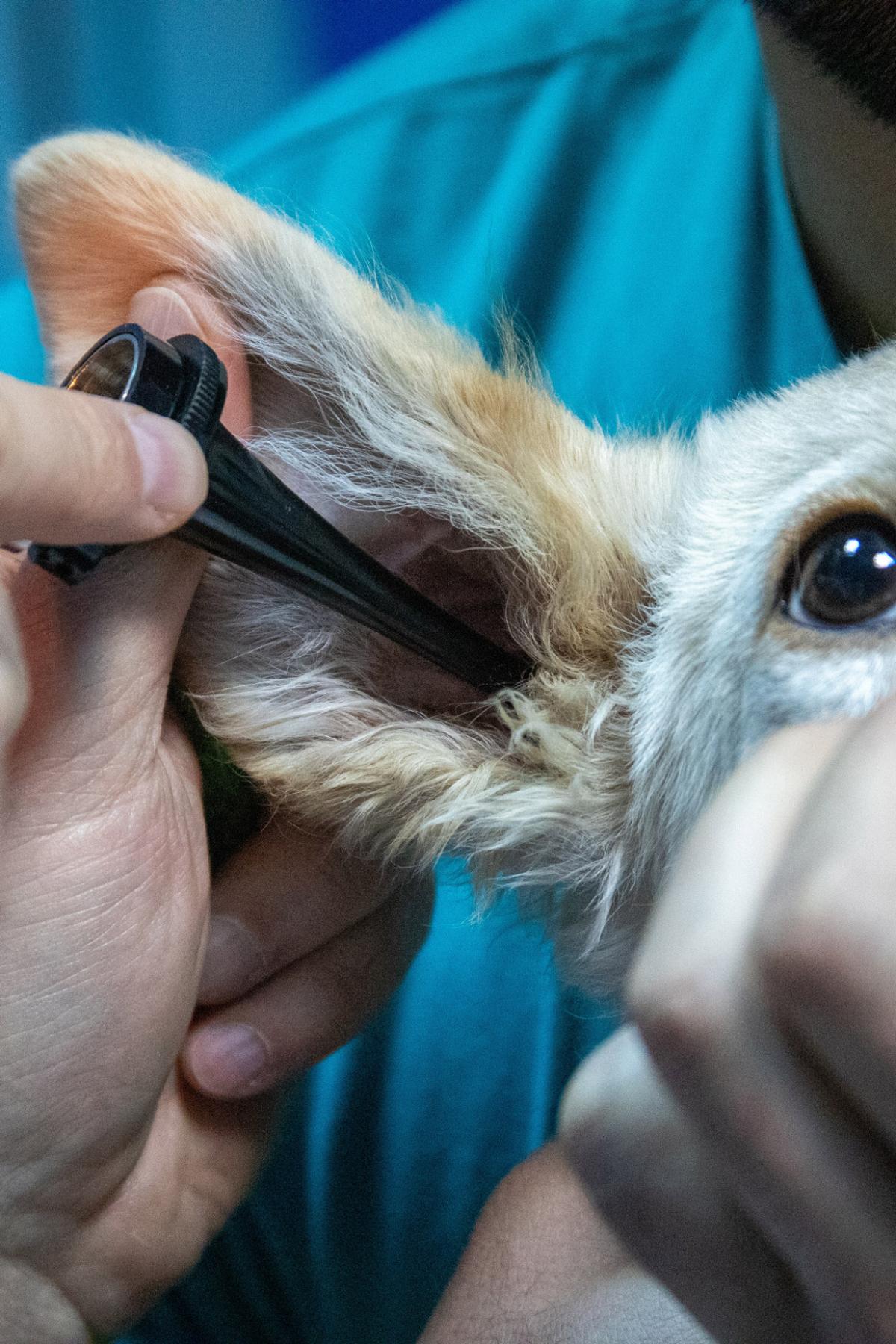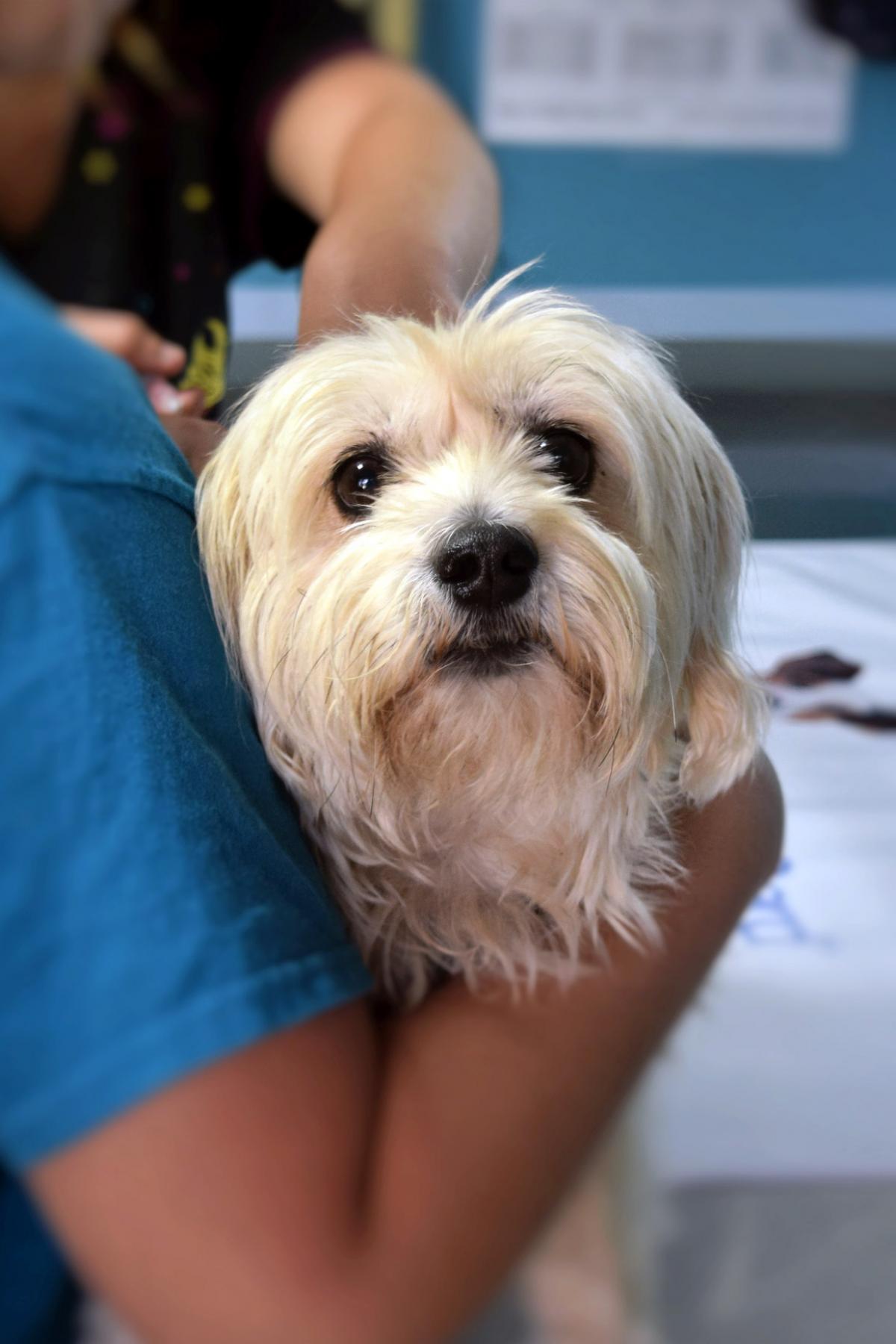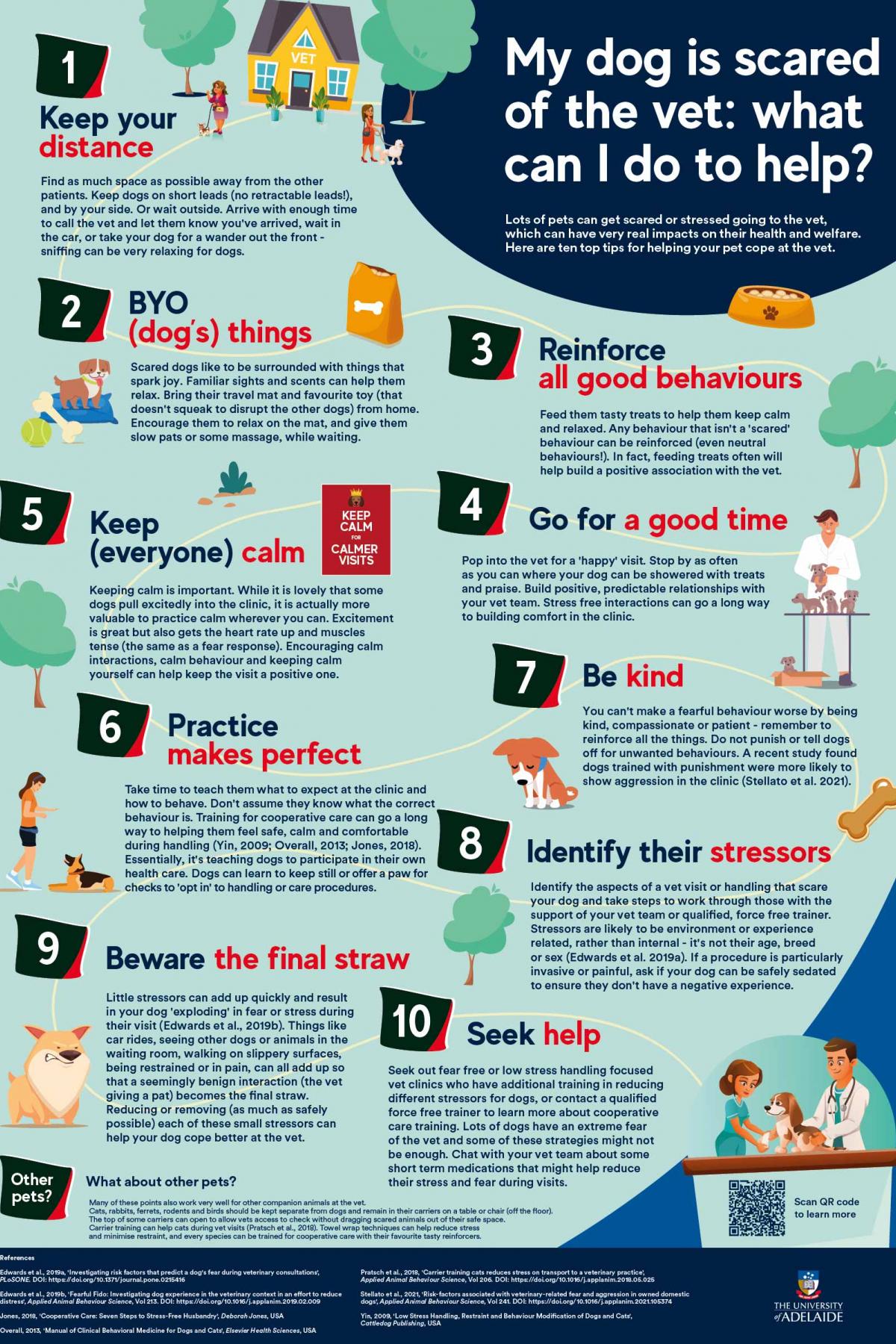Why are dogs scared of the vet and what can I do to help?
Investigating the bark side of veterinary care is ruff (I shih tzu not!)
Petra Edwards from the University of Adelaide tells us why dogs fear the vet and how pet owners can make this experience more paw-sitive for everyone.

What the research says
It can cause a lot of problems when dogs and cats are scared of the vet. We hate seeing our fur-babies distressed, and vets and nurses hate treating panicky patients.
Patients that are distressed can lash out and scratch or bite; they often take longer to work with; and the signs of fear and stress can mask the signs of pain and illness, which makes an accurate diagnoses more difficult for the veterinarian.
Investigating vet visits has been difficult as they are such complex experiences to unpack. Here’s my five years of research at the University of Adelaide's School of Animal and Veterinary Sciences summarised into a few main points:

Image by mbfye from Pixabay
Your dog decides what’s scary, not you
There are lots of aspects of a vet visit that might make your dog scared or stressed. There are different sights, sounds, noises, slippery surfaces and people. Being in pain can contribute too, or maybe something that happened last time they were at the vet.
Our review of the literature suggests that your dog's stress or fear is based on their perception of each of these things and how they stack up together.
Extreme responses - and even dramatic ones that we might think are funny - are legitimate signs of emotional distress and should be taken seriously, because they won’t get better on their own.
Your dog’s breed, age, or sex doesn’t matter
Things like age, sex, or breed don't make as much of a difference as you might think. Our research found 7% of the fear observed by pet parents was due to those characteristics.
This means that 93% of what causes fear of the vet is most likely in the environment or based on a current or previous experience.
How does it start?
There doesn’t need to be a single ‘traumatic’ event for dogs to start fearing the vet - although that can happen too. Instead it might be a combination of multiple and seemingly uneventful visits, in which fear or stress add up over time.
We also investigated how healthy dogs respond to a routine exam in a fake veterinary clinic (Edwards et al. 2022).
Just because you don’t see it now, doesn’t mean it won’t happen later
Fear of the vet is more common than you’d think.
My research at the University of Adelaide showed that 40% of dogs experienced some form of fear during a vet exam. One in seven dogs show severe to extreme fear.
Even if your dog is not currently showing signs of fear or stress at the vet, it doesn't mean it won't develop later. Prevention is always better than a cure. Take steps to reduce discomfort, fear or stress at every vet visit as often as possible.
There’s no ‘one size fits all’ solution
In the same study looking at routine exams (Edwards et al. 2022), we found dogs responded differently to each step of the exam, e.g. checking eyes or teeth, rate of breathing, legs and paws.
This means that we can’t assume it’s the vaccination - or any one single aspect of handling - that causes the fear.
We also found that dogs showed fear in a pretend vet clinic that we set up in a university lecture room, so it is also not just the clinic that upsets them. However, being in a vet clinic might just make things more scary or stressful.
Other experiences matter too
It's easy to assume that fear of the vet is an isolated incident. However, similar experiences outside of a vet clinic can influence how they respond within a clinic.
Any experience at home, or elsewhere that involves handling, examination or restraint can look or feel a lot like a vet exam for your dog.
If they have a scary or painful experience such as with nail trimming, brushing, washing, or putting on collars, harnesses or jackets, they might relate to that experience at the vet, or vice versa.
Tips on how to improve the vet experience for you and your dog
Regular veterinary visits are vital for good dog welfare. It’s important we do all we can to ensure that it is positive experience - or at least, a neutral one.
While we may not know enough about fear of the vet to create a solution for every veterinary situation, there is actually a lot that we do know. Research into behavioural science and how dogs learn can help us create a better experience for your pet.
Most of these same strategies will work brilliantly to help prevent fear from developing. They can also work well for cats or other small companion animals; you might just need to be a bit creative!
Here are my top 10 tips for unleashing the PET-ential for a more PAW-sitive veterinary experience:

Image by mbfrye from Pixabay
1. Social distance (or wait outside)
- Vet clinics were the place for social distancing before it was cool. They are not for socialising or making friends. Lots of animals you come cross may be sick, stressed out, or recovering from surgery or injury.
- Find as much space as possible away from the other patients, keep your dogs on short leads and by your side.
- Keep cats or other small companion animals in a travel cage and on a chair, bench, or table and not on the ground. Cover cages with a towel to help reduce scary sights or sounds.
- Most vet clinics now have separate consult rooms for dogs and cats – but it pays to keep all species as separate as possible.
- Otherwise, wait outside. Arrive with enough time to call the vet to let them know you’ve arrived. Wait in the car or take your dog for a wander out the front. Sniffing can be very relaxing for dogs.

Image by Conger Design from Pixabay
2. Take your dog’s favourite things
- Just like humans, scared dogs like to be surrounded with things they are familiar with, and that promote relaxation or happiness.
- Bring their travel mat from home and a favourite toy – preferably one that doesn’t squeak! Place the mat down in the waiting room and encourage them to relax on it.
- Give them slow pats and a massage while you wait. They will appreciate a safe and familiar presence to lean on.
- If your dog needs to be muzzled at the vet, purchase your own basket muzzle and practice muzzle training. It can make a lot of difference to feel comfortable in a muzzle that smells like home, rather than wearing one that smells of another stressed dog or cleaning product.

Image by StockSnap from Pixabay
3. Reinforce all good behaviours
- Unless your pet is going in for surgery, you can usually feed them tasty treats to help them keep calm and relax.
- Pairing food, or even a toy, with scary places and experiences is the best way to help change how your dog feels about them. This is a scientific process called counterconditioning.
- Reinforce every positive action your dog does in the vet clinic – every time they look at you, come closer, stand still, sit or lie down, get on the scales, move into the consult room, etc. You can reinforce them continuously for remaining still while the vet checks them over - and I mean, continuously, aim for one small treat per second if they can eat that fast.
- Using a Kong®, Lickimat®, frozen beef stock (or warmer/ softer/ smellier meat treats) can help keep a dog calm. You can get very creative with food types, simply adjust their daily ration at meal times to compensate!

4. Go for a good time, not a long time
- Just pop into your vet for a ‘happy’ visit. Call ahead first but stop by the waiting room as often as you can where your dog can be showered with treats and praise, and nothing bad or scary happens. These are purely happy and social visits where you aim to leave with your dog wanting to stay with their new favourite people.
- You could go one step further and book a ‘social consult’ with the vet. Some clinics offer special rates for these because there is so much value in encouraging positive relationships with their patients.

Image by Mirko Sajkov from Pixabay
5. Keep calm and… just keep calm
- Keeping calm is important. Excitement is great, but also gets the heart rate up and muscles tense - all the things also used in a flight or fight response.
- It is easy for an experience to turn bad quickly once emotions run high, which can also make accurate diagnoses more difficult.
- Focus on a calm sit or settle on the mat. Bring a Kong®, use a snuffle mat, or allow your dog to sniff outside.
- Calm also applies to you – if you’re worried about how your dog will respond, don’t forget to breathe, and relax yourself. Your stress won’t necessarily cause your dog to be stressed, but it probably won’t help the situation either.
6. Practice makes perfect
- Dogs learn better when they’re not scared - same as us, actually. Teaching them how to behave at home first is the best way to start a positive veterinary experience.
- Cooperative care training essentially teaches dogs to voluntarily participate in their own care. It allows the dog to focus on one familiar and safe task to do (e.g. a chin rest), and gives them the chance to ‘opt in’ to procedures. Think of the difference between being dragged to the dentist as a kid, and choosing to go as an adult; neither are your idea of a good time, but one is significantly more traumatic than the other.
- We trained our 60kg Rottweiler Gus for this type of handling by teaching a chin rest and lying on the side. Of course, this trust and comfort in cooperative care doesn’t happen overnight. But you might be pleasantly surprised at just how much having a little more control - or being restrained a little less - may change your dog’s perception of a vet visit.
- For dogs that have extreme panicked or aggressive responses at the vet, this type of training won’t fix everything, but it can certainly help as part of a larger management plan.

Image by Mylene2401 from Pixabay
7. It’s good to be kind
- Aggression in the vet clinic stems from fear, and it won’t get better if you ignore it, or if you tell your dog off for being ‘silly’. Don’t punish or tell off your dog for any unwanted behaviours. This recent study found that dogs trained with punishment were significantly more likely to show aggression in a clinic (Stellato et al. 2021).
- You won't make a fearful behaviour worse by being kind, compassionate and patient. Your dog won't get more scared of the vet because you're kind, or even if you give them tasty food rewards.
- A kind supportive presence will only help them feel and cope better.

Image by Mirko Sajkov from Pixabay
8. Identify your dog's stressors
- Identify which aspects of a vet visit or handling experience make your dog scared, and take steps to work through that with the support of your vet care team or a qualified force-free trainer.
- Some examples include: Examining dogs on a floor instead of the table, helping the vet by holding your dog's paw yourself (after learning how to do so correctly and safely), examining dogs in a courtyard or outside of the clinic if safe, or investing in some short term sedation or anti-anxiety medications for particularly invasive checks or procedures (if safe).
- Our research provides a good summary of the different aspects of a visit that might cause fear in dogs.
Image by Aleksandr Tarlõkov from Pixabay
9. Beware of the final straw
- Different stress events can add up in a short space of time and can result in your dog ‘exploding’ in fear or stress at the vet. This is commonly referred to as trigger stacking.
- There are lots of small things that happen in the lead up to visiting the vet. Normally your dog could cope with each of them individually, but they add up and put your dog over their coping threshold. The vet reaching down to pat them might be the small thing at the end of a long line of stressors that sets your dog off.
- Additional stressors might include:
- Car rides
- Being on lead
- Slippery surfaces
- Cats or other dogs
- Meeting strangers
- Being handled
- Taking steps to reduce the impact of these stressors every step of the way can make a big difference in your dog’s overall experience.

Image by JC from Pixabay
10. Seek help
- If you have noticed rapid mood changes at the vet, or if your dog's fear has become worse quickly over the past few visits, it may be time to ask for help.
- Lots of dogs have extreme fear of the vet. If you have one of these dogs, the above strategies might help take the edge off and improve the experience slightly, but it will also be valuable to chat with your vet about some short term medications to help your dog cope better during visits. Pre-visit pharmaceuticals are usually given before you go to the vet to help reduce your dog’s fear, stress or anxiety. The medication helps stop the fear getting worse during the visit, which means negative experiences don’t add up as much over time.
- If you want to prevent it from happening in the first place, or simply want to try some different training with your dog (cooperative care), then consult with a qualified dog trainer. They can provide a much more tailored approach than the general tips above.
Sciences research in focus

Image by City of Charles Sturt
Petra Edwards is an animal behaviour scientist from the School of Animal and Veterinary Sciences at the University of Adelaide.
Petra is currently awaiting her thesis review for her PhD research investigating how dogs experience their vet visits and identifying PET-ential strategies to reduce stress at the vet.
At the start of her PhD, Petra was surprised to find this field of research was relatively new, and that we didn’t know much about how a dog’s fear of the vet develops
She has a Bachelor of Science in animal behaviour and completed an honours year researching animal behaviour.
Petra's dog Gus (videos above) required extensive, invasive long term cancer treatments in 2020 and his calm cooperative care behaviours at the vet made providing that care for him easier.
She also knows what it's like to have a Suspicious Scruffy (or Fearful Fido) at the vet, and is grateful that her research has been able to shed some light on an issue that impacts thousands of dogs, their parents and vet care teams around Australia.
Media: Petra is available for interviews on this subject and can be contacted via petra.edwards@adelaide.edu.au.

Resources
Posters - My dog is scared of the vet, what can I do to help?
Articles
- Fearful Fido: Investigating dog experience in the veterinary context in an effort to reduce distress – Applied Animal Behaviour Science
- Investigating risk factors that predict a dog’s fear during veterinary consultations – PLoS ONE
- At the heart of a dog's veterinary experience: Heart rate responses in dogs vary across a standard physical examination - Journal of Veterinary Behavior
